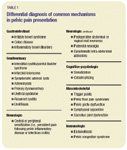Grand Rounds: A thorough approach to pelvic pain
With a treatment algorithm that encourages gynecologists to think 'outside the box,' one expert focuses on approaches originally developed for neuropathic pain, irritable bowel syndrome, and low back pain.

The pelvic part of the term likewise is not clearly defined. Some would consider symptoms including the lumbosacral back, buttocks, hip, perineum, or abdomen in this class of disorders, while others prefer to limit it to disorders associated with visceral dysfunction (i.e., urinary urgency, constipation, or dysmenorrhea). The role of endometriosis, pelvic adhesions, leiomyoma, symptomatic ovarian cysts, inflamed bladder mucosa, psychologic factors, or sensitized neural pathways all remains unclear. A published survey of clinicians confirms this is a challenging problem to treat, partly because financial reimbursement has not kept pace with the complexity of treatment.1
For our purposes, we'll focus on pain management, drawing on approaches developed for conditions outside of gynecology, such as neuropathic pain, irritable bowel syndrome (IBS), and low back pain. Much of the algorithm I propose here focuses on the neurologic system but all of the proposed components of this program are possible in the typical gynecologist's hands.

Making the diagnosis
Taking a history. The history needs to be thorough, but there is no need to prolong a first visit by obtaining all these elements at the first, or even second visit. Ask about the quality, location, and temporal characteristics. Cramping pain certainly may suggest a visceral cause, particularly when paired with visceral dysfunction; burning pain is often described in "neuropathic" pain conditions. Also ask in particular about life events or medical issues occurring around the time of the initial presentation. Patients developing persistent pain after a severe motor vehicle accident, or following major pelvic surgery are more likely to have persistent, untreated musculoskeletal or neuropathic dysfunction following these insults, than to have developed a new, unrelated condition, such as endometriosis.
Keep in mind that the representation of the pelvic viscera (i.e., bladder, uterus) and somatic structures (i.e., rectus abdominis, iliopsoas, symphysis pubis) is likely overlapping in the CNS.3 Thus, the same location of pain reported by two different patients may separately result from trigger points (local areas of spasm) in the abdominal wall in one woman, and adenomyosis invading into the uterine myometrium in another.
